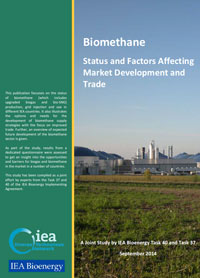| Sep 11, 2014 | |
Study: The biomethane market needs clear frame conditions for further growth |
|
| (Nanowerk News) Biomethane as a substitute for the fossil energy carrier natural gas offers a variety of options and applications for a sustainable energy supply. Nevertheless, a consequent market penetration is still pending because of a lack of standardized and transnational frame conditions. | |
 Scientists of the Helmholtz Centre for Environ-mental Research (UFZ) and the German Biomass Research Centre (DBFZ) and other Members of the IEA Task 37 (Energy from Biogas) and the Task 40 (Sustainable Bi-oenergy Trade) just summarized how the biomethane market developed in the IEA (International Energy Agency) member states and which factors are necessary for further growing ("Biomethane - Status and Factors Affecting Market Development and Trade"). In most of the IEA member states the fossil energy carrier natural gas still plays an im-portant and partiallypartially increasing role in the national energy supply. This is due to a well-developed infrastructure of gas networks, gas stations, and various modes of trans-portation by e.g. vessels. However, mainly due to the significantly lower greenhouse gas emissions, the energy security and the protection of finite resources, several countries initiated support programs for biomethane (methane from biomass).This is due to a well-developed infrastructure of gas networks, gas stations, and various modes of transport by tanker trucks or ships. Still have, mainly due to the significantly lower greenhouse gas emissions, energy security and the protection of finite resources already several countries initiated the gradual transition from fossil natural gas resource on renewable energy sources biomethane (methane from biomass). |
|
| The newly published study „Biomethane – status and factors affecting market development and trade“, gives an up-to-date and comprehensive overview of the production technologies of biomethane (upgrading of biogas and Bio-SNG), the grid injection and the use in various IEA member states. Moreover, besides the description of the framework, the options and needs for the development of larger biomethane supply strategies are also illustrated. The authors finalize the study with concrete recommendations how the remaining barriers can be removed and the market development can be promoted step by step. | |
| Greenhouse gas reduction potential of more than 80 percent | |
| Due to the benefits (i) independence from natural gas imports, (ii) the strengthening of rural areas, (iii) and its promising application areas (fuel, cogeneration, heat), biomethane is considered as a promising alternative to fossil fuels. As far as the final composition of the biomethane is consistent with the various natural gas quality levels in the market it can serve as a substitute for natural gas. In addition, biomethane can also be transported and stored as natural gas. Last but not least, greenhouse gas emissions, depending on the plant design and operation as well as the accounting method, can be reduced in comparison to fossil fuels by more than 80 percent. The study already stated a transnational increasing interest in biomethane. According to the report around 280 biogas upgrading plants in different countries with a production capacity of around 100,000 Nm3/h of biomethane are already in operation. | |
| Transnational frame conditions are required | |
| A transnational biomethane market is, according to the study, still at the beginning. However, various strategies, investment programs, funding and utilization concepts have been adopted in the investigated countries. Due to the complex supply chain there are various ecological, economic, administrative and political barriers for a market implementation of biomethane. For a sustainable and international implementation appropriate technical standards, sustainability requirements and political as well as financial support (compensation / promotion / preference), in order to significantly advance the development of an international biomethane trade, are necessary. |
| Source: Helmholtz Centre for Environmental Research |
